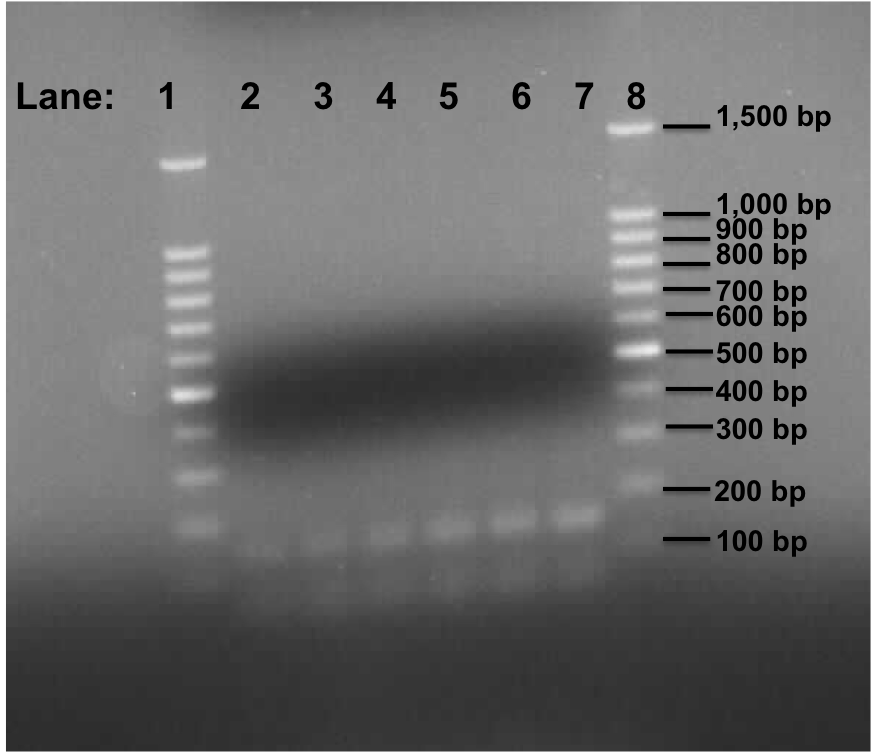Team:Newcastle/9 August 2010
From 2010.igem.org

| |||||||||||||
| |||||||||||||
Contents |
Amplification of Pspac_oid promoter by PCR
Aim
The aim of this experiment is to amplify the Pspac_oid promoter fragment from plasmid pMutin4 for the construction of rocF BioBrick using Phusion PCR.
Materials and Protocol
Please refer to PCR for Phusion PCR protocol. The details for the 4 PCR reactions are mentioned below:
PCR
| Tube | Part to be amplified | DNA fragment consisting the part | Forward primer | Reverse Primer | Melting Temperature (Tm in °C) | Size of the fragment (in bp) | Extension time* (in seconds) |
|---|---|---|---|---|---|---|---|
| 1 | Pspacoid Promoter | pMutin4 | P1P1 forward | P2P1 reverse | 58 | 106 approx. | 15 |
| 2 | Pspacoid Promoter | pMutin4 | P1P1 forward | P2P1 reverse | 59 | 106 approx. | 15 |
Table 1: Table represents 4 different Phusion PCR reactions for the amplification of Pspac_oid promoter, so that it can be ligated together with other fragments for the construction of rocF with the help of Gibson Cloning method.
- The extension rate of the Phusion polymerase is 1Kb/ 30 seconds. Therefore the extension time of each PCR reaction is different.
- To learn more about the rocF fragments, please refer to the Cloning strategy for rocF.
Discussion
All the 2 Phusion PCR reactions were done however, gel electrophoresis will be done later today, to check whether the fragments have actually amplified or not.
Conclusion
Today afternoon, we would be running gel electrophoresis to check the outcome of the 2 PCR reactions and later all the fragments will be ligated with help of Gibson protocol if the fragments have amplified.
Amplification of Pspac_oid promoter by PCR
Aim
The aim of this experiment is to amplify the Pspac_oid promoter fragment from plasmid pMK-RQ containing Biobrick kinA and plasmid pMK-RQ containing stochastic switch developed by Team Newcastle 2009 for the construction of rocF BioBrick using Phusion PCR.
Materials and Protocol
Please refer to PCR for Phusion PCR protocol. The details for the 2 PCR reactions are mentioned below:
PCR
| Tube | Part to be amplified | DNA fragment consisting the part | Forward primer | Reverse Primer | Melting Temperature (Tm in °C) | Size of the fragment (in bp) | Extension time* (in seconds) |
|---|---|---|---|---|---|---|---|
| 1 | Pspacoid Promoter | Plasmid containing kinA | P1P1 forward | P2P1 reverse | 58 | 106 approx. | 15 |
| 2 | Pspacoid Promoter | Plasmid containing kinA | P1P1 forward | P2P1 reverse | 59 | 106 approx. | 15 |
| 3 | Pspacoid Promoter | Plasmid containing stochastic switch | P1P1 forward | P2P1 reverse | 58 | 106 approx. | 15 |
| 1 | Pspacoid Promoter | Plasmid containing stochastic switch | P1P1 forward | P2P1 reverse | 59 | 106 approx. | 15 |
Table 2: Table represents 2 different Phusion PCR reactions for the amplification of Pspac_oid promoter, so that it can be ligated together with other fragments for the construction of rocF with the help of Gibson Cloning method.
- The extension rate of the Phusion polymerase is 1Kb/ 30 seconds. Thus the extension time of each and every PCR reaction is slightly different.
- For learning about the rocF fragments, please refer to the Cloning strategy for rocF.
Discussion
All the 4 Phusion PCR reactions were done however, gel electrophoresis will be done later today, to check whether the fragments have actually amplified or not.
Conclusion
Today afternoon, we would be running gel electrophoresis to check the outcome of the 4 PCR reactions and later all the fragments will be ligated with help of Gibson protocol if the fragments have amplified.
Gel Electrophoresis for Amplified Pspac_oid promoter
Aim
The aim of the experiment is to perform gel electrophoresis for the two PCR reactions Pspac_oid promoter amplified from plasmid pMutin4 and from plasmid pMK-RQ containing Biobrick kinA and plasmid pMK-RQ containing stochastic switch developed by Team Newcastle 2009 which took place today morning and thus confirm that they were successful.
Materials and Protocol
Please refer to: Gel electrophoresis.
Result
Figure 1: Gel electrophoresis of the lacI and Pspac_oid promoter.
- Lane 1: 100bp DNA ladder
- Lane 2: Plamid pMutin4 containing Pspac_oid promoter
- Lane 3: Plamid pMutin4 containing Pspac_oid promoter
- Lane 4: Plamid pMK-RQ (kinA BioBrick) containing Pspac_oid promoter
- Lane 5: Plamid pMK-RQ (kinA BioBrick) containing Pspac_oid promoter
- Lane 6: Plamid pMK-RO (stchastic switch BioBrick) containing Pspac_oid promoter
- Lane 7: Plamid pMK-RO (stchastic switch BioBrick) containing Pspac_oid promoter
- Lane 8: 100bp DNA ladder
| Pspac_oid pormoter | |
|---|---|
| Size of the Fragment (in bp) | 148 approx. |
Table 3: Table represents the size of the Pspac_oid fragment represented as bands on the gel in all the lanes.
Discussion
We found two bands in the all lanes out of which one is of approximately of 150 bp is size and the other band is of 80 bp approximately in size.
Conclusion
This experiment shows that the PCR reaction was not perfectly successful for the Pspac_oid fragment. The problem is that there are 2 fragments on the gel instead of 1 and the second band which of 80bp in size might be corresponding to primer dimers. When we checked the primer sequence again, we found that there is a high complementarity within the primers itself and thus the amplification of the Pspac_oid fragment is not taking place at a desired rate. The first band present on the gel can be of the Pspac_oid fragment and thus tomorrow 10th August, 2010, we would be doing gel extraction for the fragment and will check whether these fragments are of Pspac_oid or not.
 
|
 "
"
